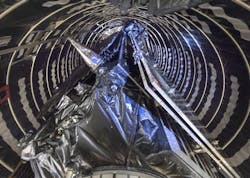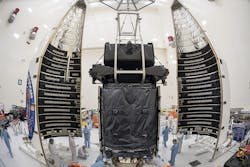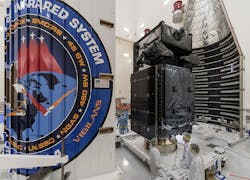U.S. Air Force SBIRS GEO Flight-4 satellite completes baseline constellation, achieves first light
BUCKLEY AIR FORCE BASE, Colo. The U.S. Air Force's fourth Space Based Infrared System (SBIRS) satellite, SBIRS GEO Flight-4 or GEO-4, has achieved first light, having transmitted its first images back to Earth. The milestone occurred when the satellite, built by Lockheed Martin (NYSE:LMT), which built a $350 million satellite facility outside Denver, turned on its powerful sensors for the first time during space vehicle checkout.
"First light was a tremendous milestone for SBIRS GEO Flight-4 and we are very pleased with the high quality and definition of the images we received back," says Tom McCormick, vice president of Lockheed Martin's Overhead Persistent Infrared (OPIR) systems mission area. "With the launch of this satellite, SBIRS can now provide global coverage, with better-than-specified sensor pointing accuracy and the ability to detect even more targets than anticipated."
SBIRS GEO Flight-4 is the latest satellite to join the Air Force's orbiting missile warning constellation. The satellite, equipped with powerful scanning and staring infrared surveillance sensors, collects data for use by the U.S. military to detect missile launches, support ballistic missile defense, expand technical intelligence gathering, and bolster situational awareness on the battlefield.
Launched on 19 Jan. 2018, SBIRS GEO Flight-4 began responding to the Air Force's 460th Space Wing's commands just 37 minutes after liftoff. Using its liquid apogee engine, the satellite propelled itself to a Geosynchronous Earth Orbit (GEO) altitude of about 22,000 miles, where it deployed its solar arrays and antennas, and began initial check out.
SBIRS GEO Flight-4 completes the baseline SBIRS constellation. It joins SBIRS GEO Flights-1, 2, and 3, which were launched in 2011, 2013, and 2017 respectively.
In 2014, the Air Force awarded Lockheed Martin a $1.86 billion contract for the SBIRS GEO-5 and 6 spacecraft. Following that award, the company offered the government a no-cost contract modification, transitioning to its modernized LM 2100 satellite bus, to demonstrate how production cycle times and costs could be drastically reduced on future space vehicles. The modification also provides improved resiliency and validates how modernized sensor suites could be incorporated.
SBIRS GEO-5 and GEO-6 are currently greater than 50 percent through production and on track for delivery to the Air Force very early in the next decade. Infrared surveillance and missile warning satellites, known as GEO-5 and GEO-6, will be based on Lockheed Martin’s modernized LM 2100 spacecraft — an update that improves system affordability and resiliency while also adding the flexibility to use future payloads.
SBIRS is the next-generation strategic missile-warning system replacing the 1970s Defense Support Program constellation. SBIRS delivers global, overhead, persistent, taskable 24/7 infrared surveillance capabilities to meet 21st-century demands for early warning of missile launches, while simultaneously supporting other critical missions including missile defense, technical intelligence and battle space awareness. The SBIRS objective constellation consists of four GEO satellites, two highly elliptical earth orbit (HEO) payloads and associated ground infrastructure. The fifth and sixth satellites will replenish on-orbit satellites in the constellation to maintain the required operational mission capabilities.
The SBIRS program is led by the Infrared Space Systems Directorate at the U.S. Air Force Space and Missile Systems Center. Lockheed Martin Space Systems Company is the SBIRS prime contractor, Northrop Grumman Electronic Systems, Azusa, Calif., is the payload integrator. The 460th Space Wing at Buckley AFB in Aurora, Colo., operates the SBIRS system.
Headquartered in Bethesda, Maryland, Lockheed Martin is a global security and aerospace company that employs approximately 100,000 people worldwide and is principally engaged in the research, design, development, manufacture, integration and sustainment of advanced technology systems, products and services.
The U.S. Air Force’s Space Based Infrared System (SBIRS) Geosynchronous Earth Orbit (GEO) Flight-4 satellite, built by Lockheed Martin, completed encapsulation on 9 January 2018. SBIRS GEO Flight-4 is the latest satellite to join the Air Force’s SBIRS constellation, which enhances the military's ability to detect missile launches, supports ballistic missile defense, expands technical intelligence gathering, and bolsters situational awareness on the battlefield. SBIRS GEO Flight-4 iaunched in January 2018 aboard a United Launch Alliance Atlas V rocket.




